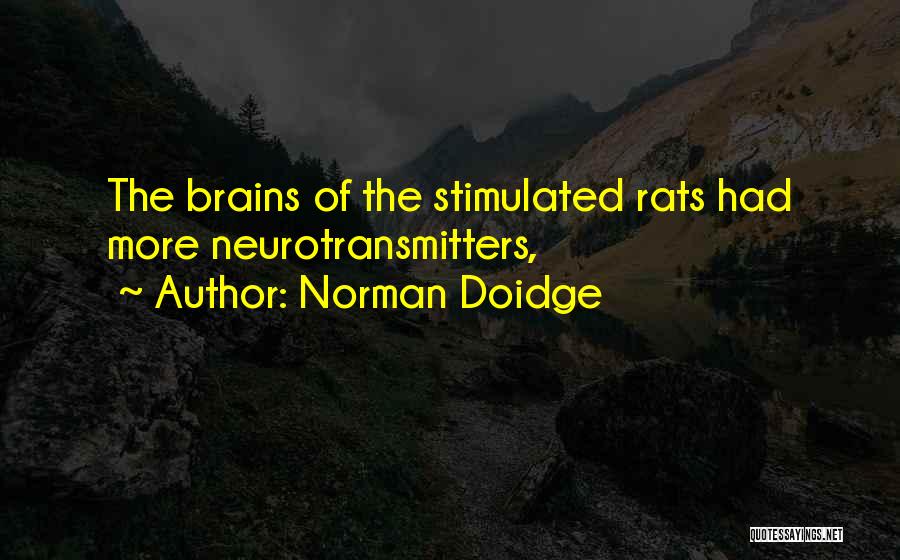Norman Doidge Quotes & Sayings
Enjoy the top 53 famous quotes, sayings and quotations by Norman Doidge.
Famous Quotes By Norman Doidge
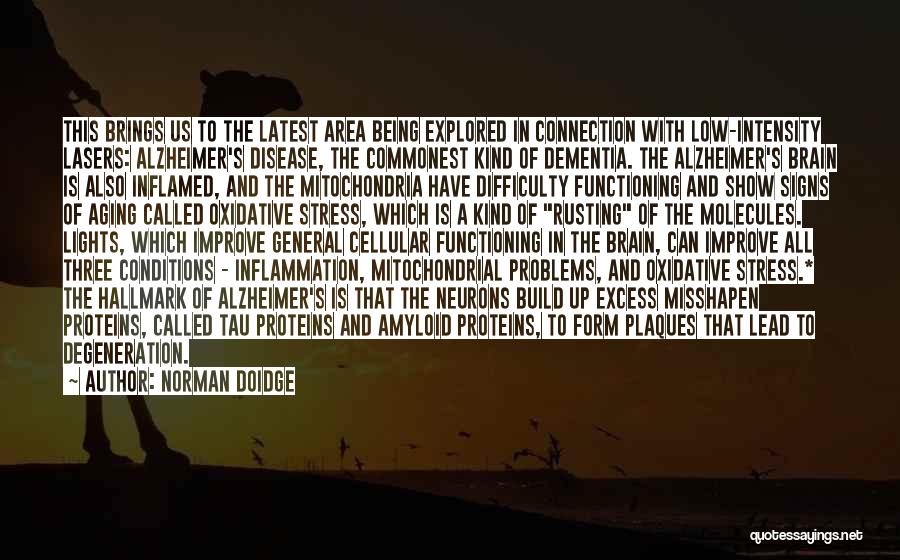
This brings us to the latest area being explored in connection with low-intensity lasers: Alzheimer's disease, the commonest kind of dementia. The Alzheimer's brain is also inflamed, and the mitochondria have difficulty functioning and show signs of aging called oxidative stress, which is a kind of "rusting" of the molecules. Lights, which improve general cellular functioning in the brain, can improve all three conditions - inflammation, mitochondrial problems, and oxidative stress.* The hallmark of Alzheimer's is that the neurons build up excess misshapen proteins, called tau proteins and amyloid proteins, to form plaques that lead to degeneration. — Norman Doidge

A quantitative EEG (QEEG) is a test that can indicate if a patient has a "noisy brain." This study is often done by advanced neurofeedback practitioners, and must be interpreted by an expert who has actually met with the patient, not simply run the information through a machine. — Norman Doidge
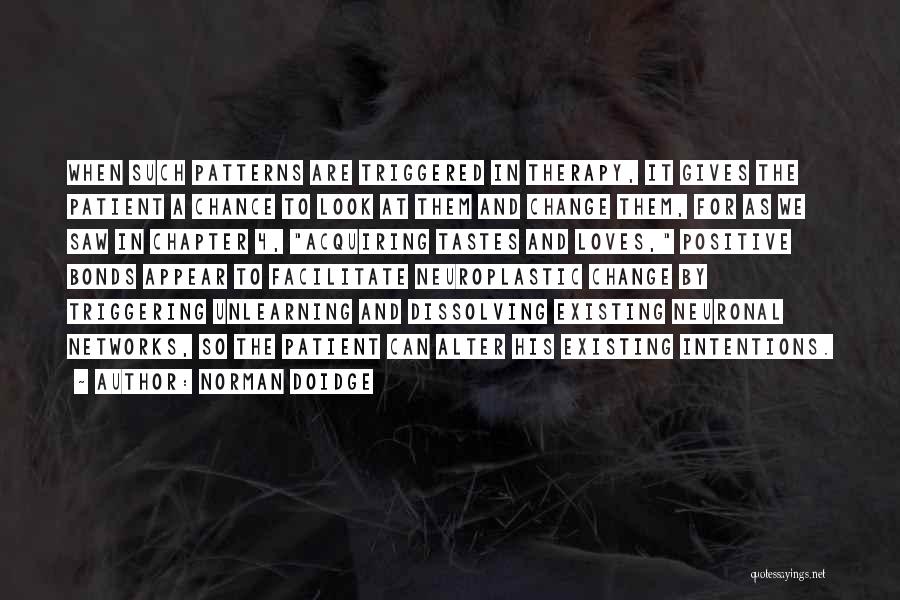
When such patterns are triggered in therapy, it gives the patient a chance to look at them and change them, for as we saw in chapter 4, "Acquiring Tastes and Loves," positive bonds appear to facilitate neuroplastic change by triggering unlearning and dissolving existing neuronal networks, so the patient can alter his existing intentions. — Norman Doidge

Everything having to do with human training and education has to be re-examined in light of neuroplasticity. — Norman Doidge
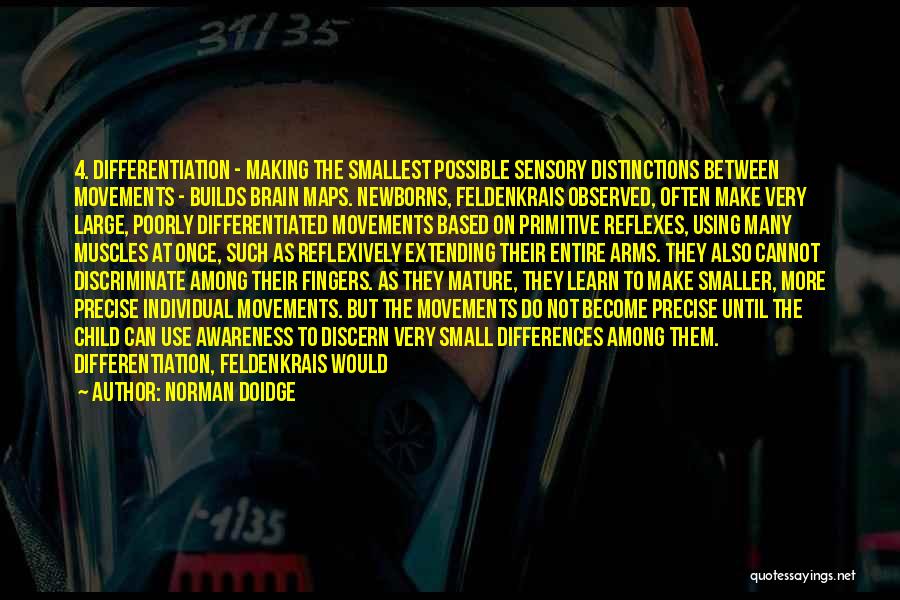
4. Differentiation - making the smallest possible sensory distinctions between movements - builds brain maps. Newborns, Feldenkrais observed, often make very large, poorly differentiated movements based on primitive reflexes, using many muscles at once, such as reflexively extending their entire arms. They also cannot discriminate among their fingers. As they mature, they learn to make smaller, more precise individual movements. But the movements do not become precise until the child can use awareness to discern very small differences among them. Differentiation, Feldenkrais would — Norman Doidge
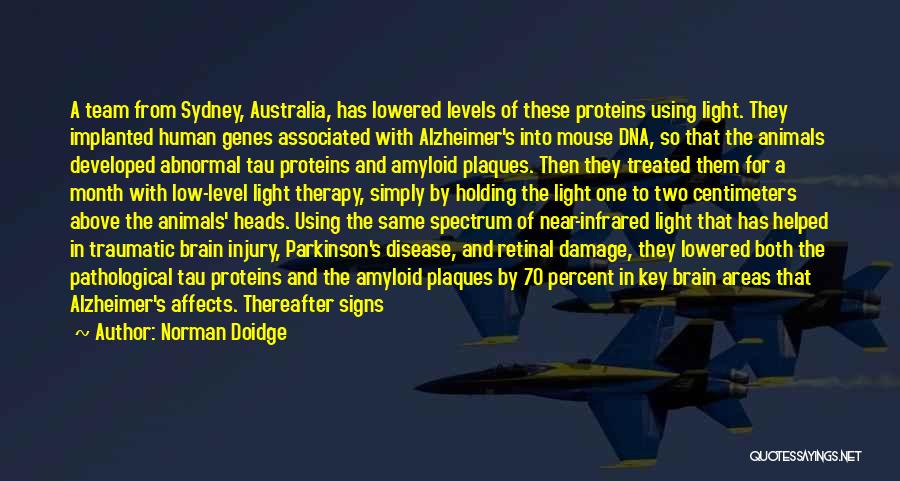
A team from Sydney, Australia, has lowered levels of these proteins using light. They implanted human genes associated with Alzheimer's into mouse DNA, so that the animals developed abnormal tau proteins and amyloid plaques. Then they treated them for a month with low-level light therapy, simply by holding the light one to two centimeters above the animals' heads. Using the same spectrum of near-infrared light that has helped in traumatic brain injury, Parkinson's disease, and retinal damage, they lowered both the pathological tau proteins and the amyloid plaques by 70 percent in key brain areas that Alzheimer's affects. Thereafter signs of "rusting" decreased, and the mitochondria, the powerhouses of the cells, improved their function. — Norman Doidge
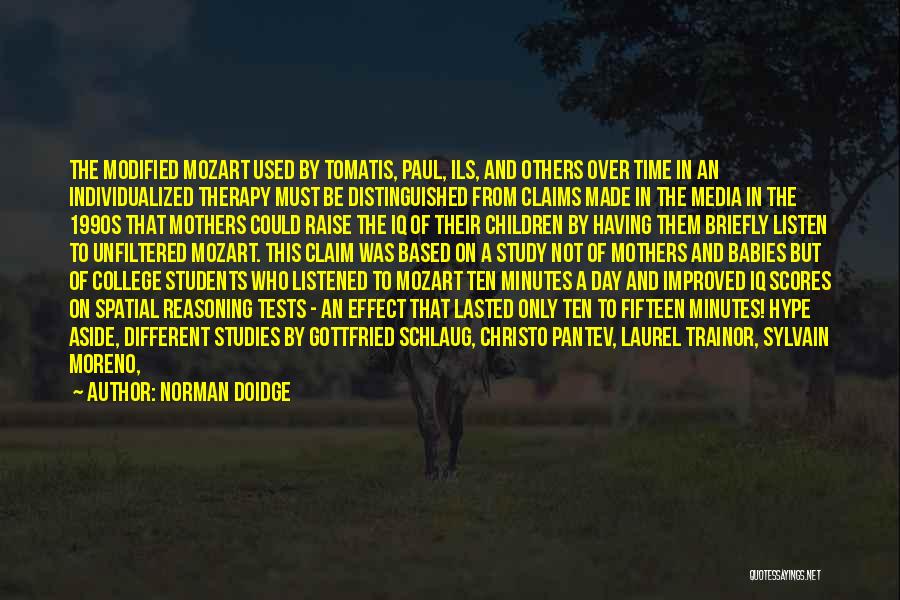
The modified Mozart used by Tomatis, Paul, iLs, and others over time in an individualized therapy must be distinguished from claims made in the media in the 1990s that mothers could raise the IQ of their children by having them briefly listen to unfiltered Mozart. This claim was based on a study not of mothers and babies but of college students who listened to Mozart ten minutes a day and improved IQ scores on spatial reasoning tests - an effect that lasted only ten to fifteen minutes! Hype aside, different studies by Gottfried Schlaug, Christo Pantev, Laurel Trainor, Sylvain Moreno, and Glenn Schellenberg have shown that sustained music training, such as learning to play an instrument, can lead to brain change, enhance verbal and math skills, and even modestly increase IQ.] — Norman Doidge
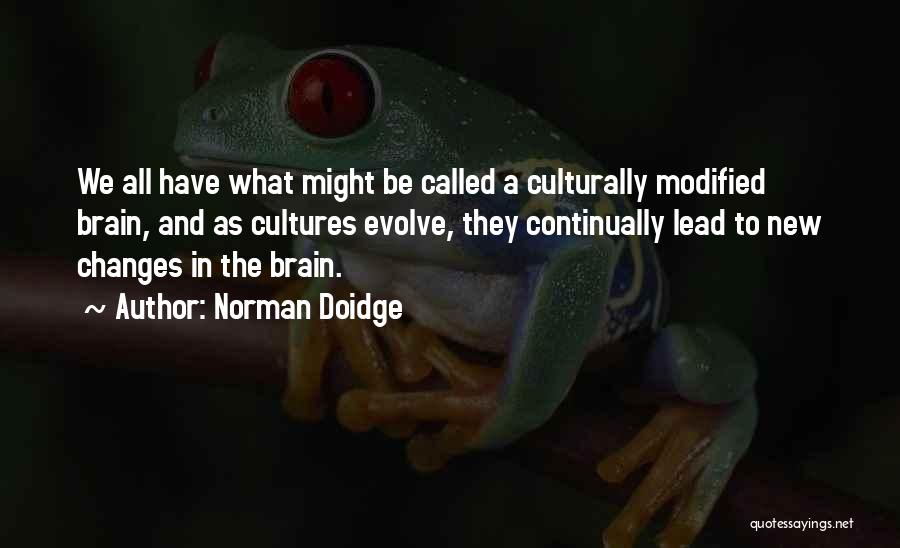
We all have what might be called a culturally modified brain, and as cultures evolve, they continually lead to new changes in the brain. — Norman Doidge
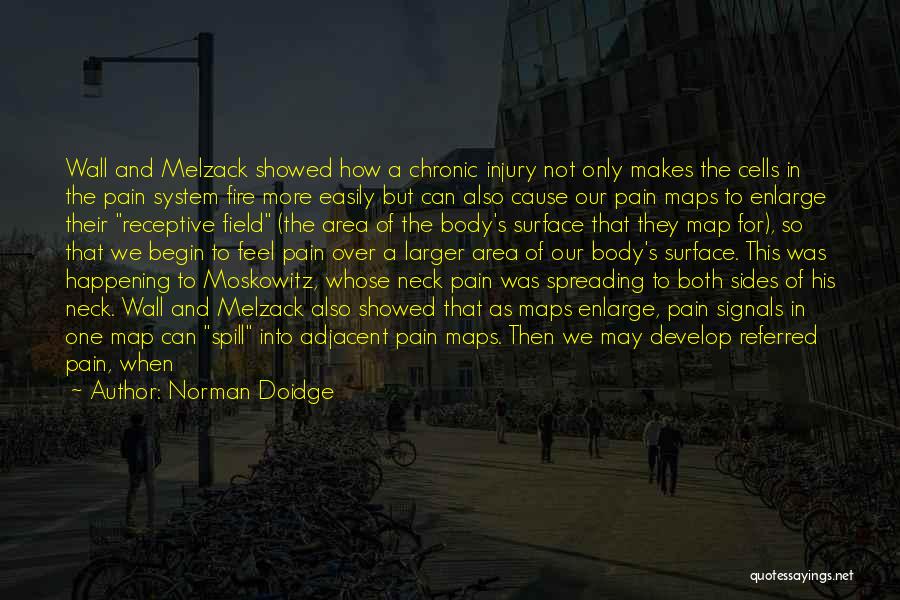
Wall and Melzack showed how a chronic injury not only makes the cells in the pain system fire more easily but can also cause our pain maps to enlarge their "receptive field" (the area of the body's surface that they map for), so that we begin to feel pain over a larger area of our body's surface. This was happening to Moskowitz, whose neck pain was spreading to both sides of his neck. Wall and Melzack also showed that as maps enlarge, pain signals in one map can "spill" into adjacent pain maps. Then we may develop referred pain, when we are hurt in one body part but feel the pain in another, some distance away. — Norman Doidge
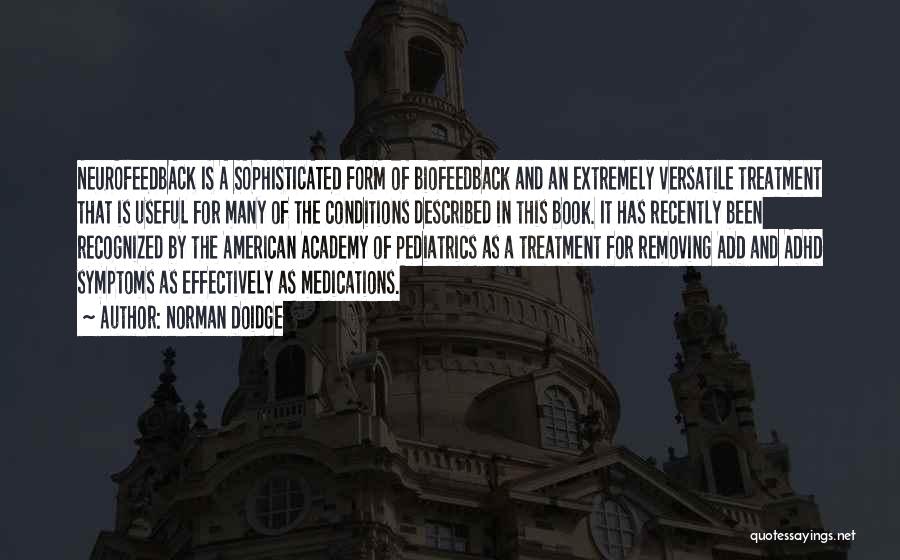
NEUROFEEDBACK IS A SOPHISTICATED FORM of biofeedback and an extremely versatile treatment that is useful for many of the conditions described in this book. It has recently been recognized by the American Academy of Pediatrics as a treatment for removing ADD and ADHD symptoms as effectively as medications. — Norman Doidge
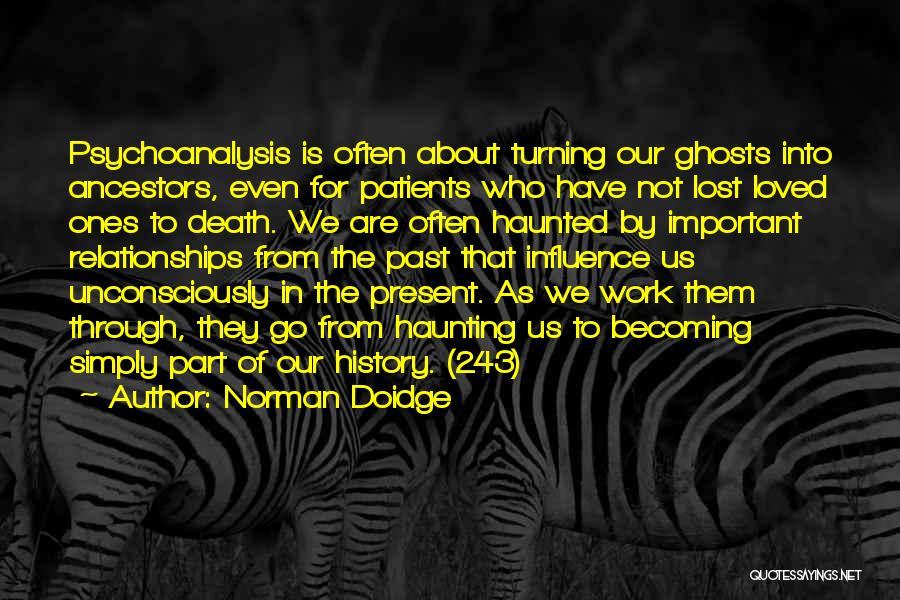
Psychoanalysis is often about turning our ghosts into ancestors, even for patients who have not lost loved ones to death. We are often haunted by important relationships from the past that influence us unconsciously in the present. As we work them through, they go from haunting us to becoming simply part of our history. (243) — Norman Doidge
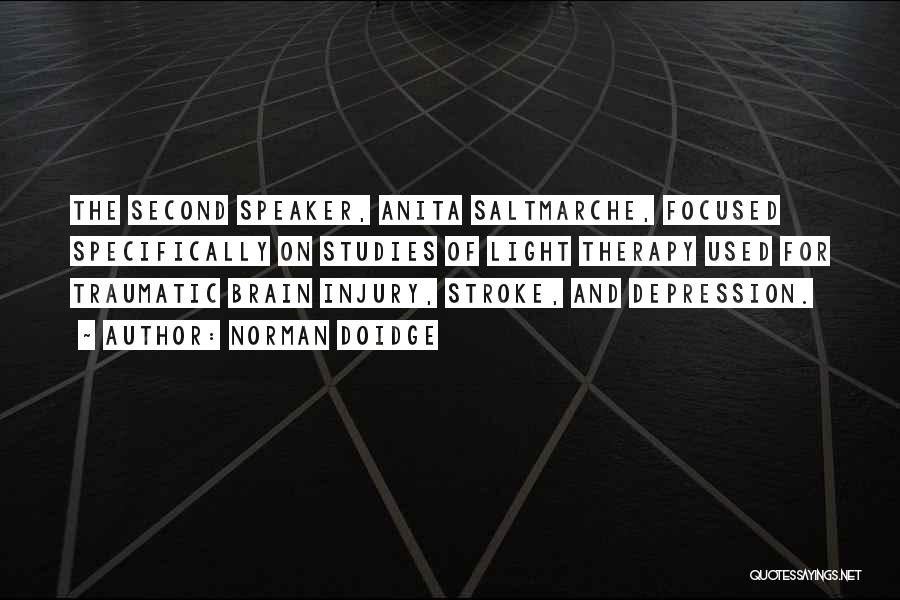
THE SECOND SPEAKER, ANITA SALTMARCHE, focused specifically on studies of light therapy used for traumatic brain injury, stroke, and depression. — Norman Doidge
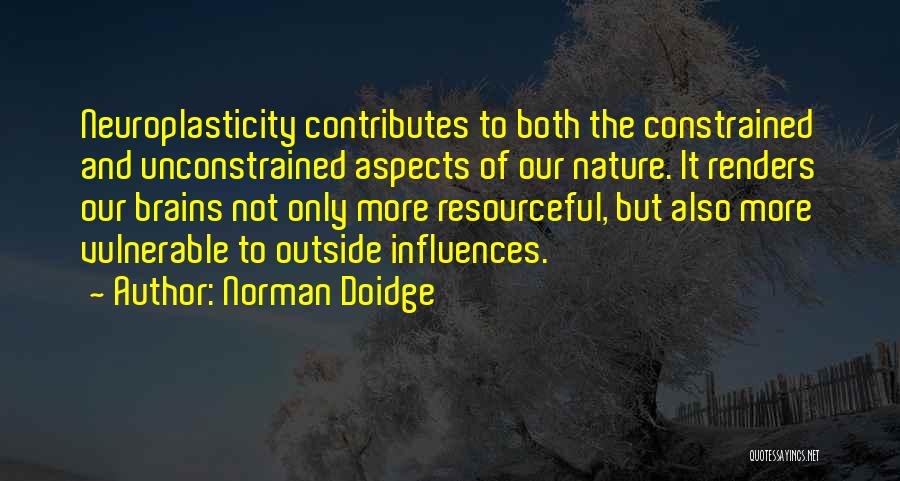
Neuroplasticity contributes to both the constrained and unconstrained aspects of our nature. It renders our brains not only more resourceful, but also more vulnerable to outside influences. — Norman Doidge
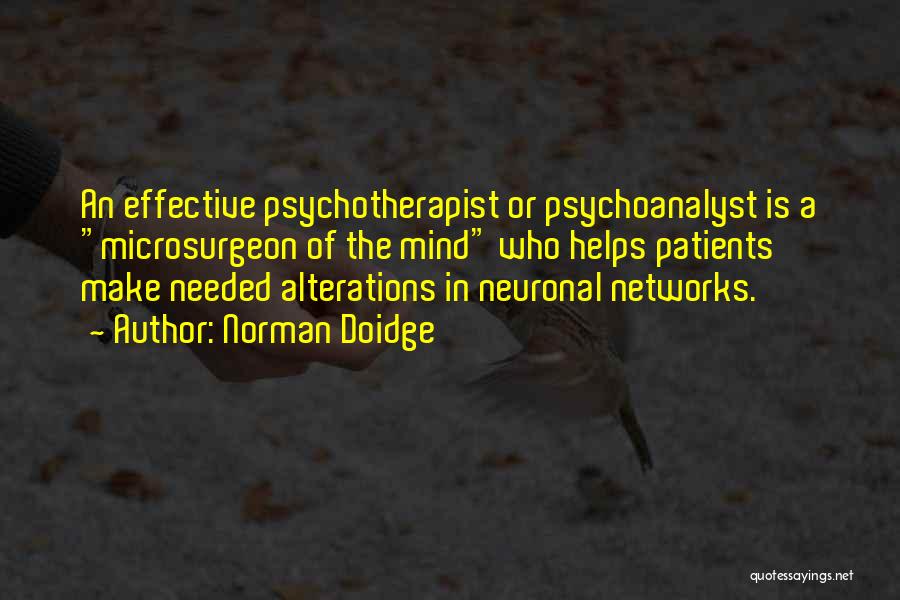
An effective psychotherapist or psychoanalyst is a "microsurgeon of the mind" who helps patients make needed alterations in neuronal networks. — Norman Doidge
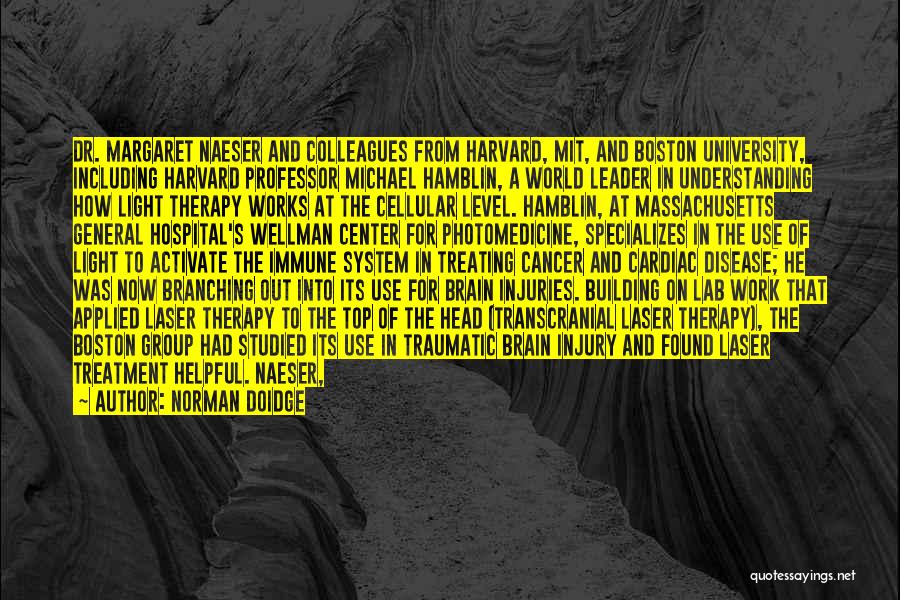
Dr. Margaret Naeser and colleagues from Harvard, MIT, and Boston University, including Harvard professor Michael Hamblin, a world leader in understanding how light therapy works at the cellular level. Hamblin, at Massachusetts General Hospital's Wellman Center for Photomedicine, specializes in the use of light to activate the immune system in treating cancer and cardiac disease; he was now branching out into its use for brain injuries. Building on lab work that applied laser therapy to the top of the head (transcranial laser therapy), the Boston group had studied its use in traumatic brain injury and found laser treatment helpful. Naeser, a research professor at the Boston University School of Medicine, had done studies using lasers for stroke and paralysis and was one of several pioneers using "laser acupuncture" by placing light on acupuncture points. — Norman Doidge
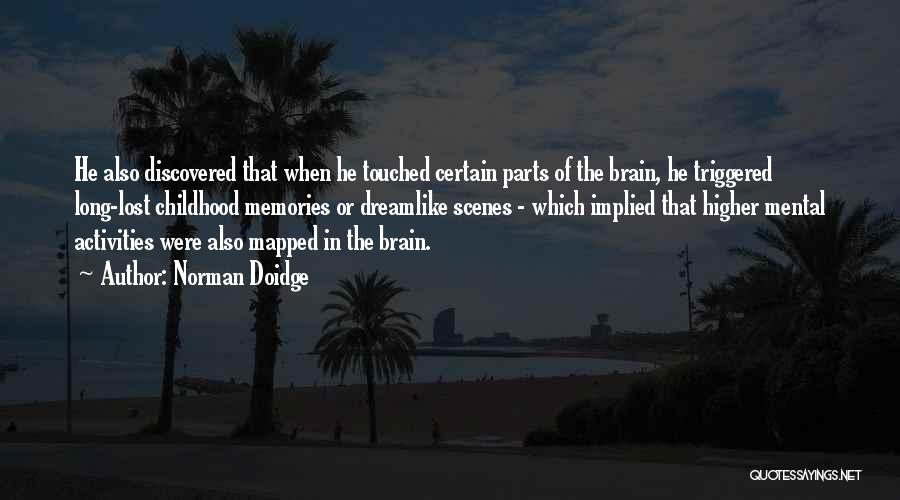
He also discovered that when he touched certain parts of the brain, he triggered long-lost childhood memories or dreamlike scenes - which implied that higher mental activities were also mapped in the brain. — Norman Doidge
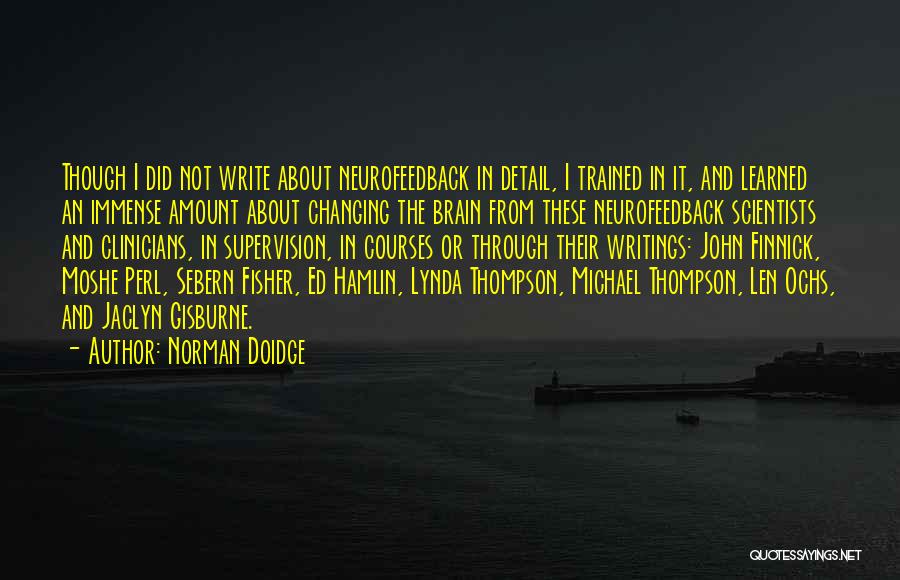
Though I did not write about neurofeedback in detail, I trained in it, and learned an immense amount about changing the brain from these neurofeedback scientists and clinicians, in supervision, in courses or through their writings: John Finnick, Moshe Perl, Sebern Fisher, Ed Hamlin, Lynda Thompson, Michael Thompson, Len Ochs, and Jaclyn Gisburne. — Norman Doidge
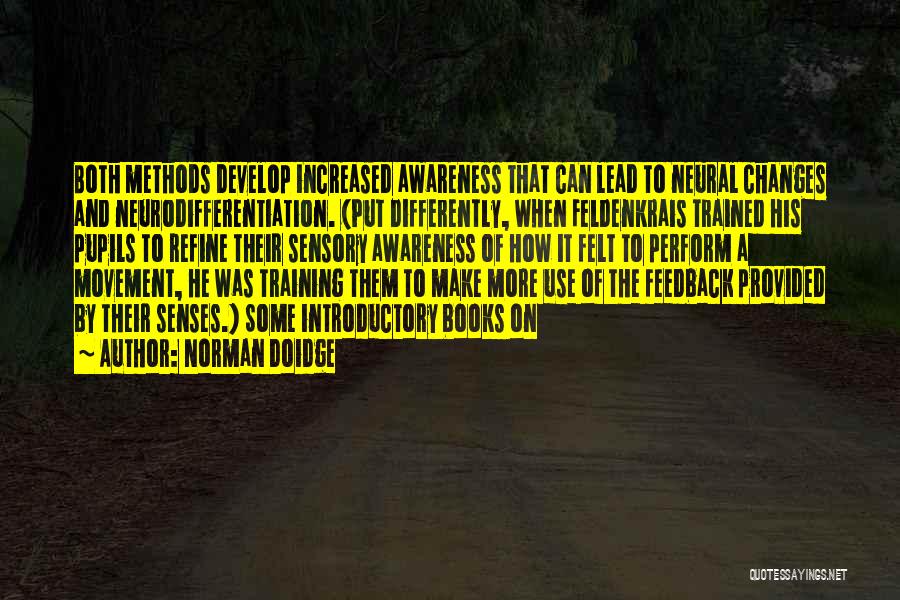
Both methods develop increased awareness that can lead to neural changes and neurodifferentiation. (Put differently, when Feldenkrais trained his pupils to refine their sensory awareness of how it felt to perform a movement, he was training them to make more use of the feedback provided by their senses.) Some introductory books on — Norman Doidge
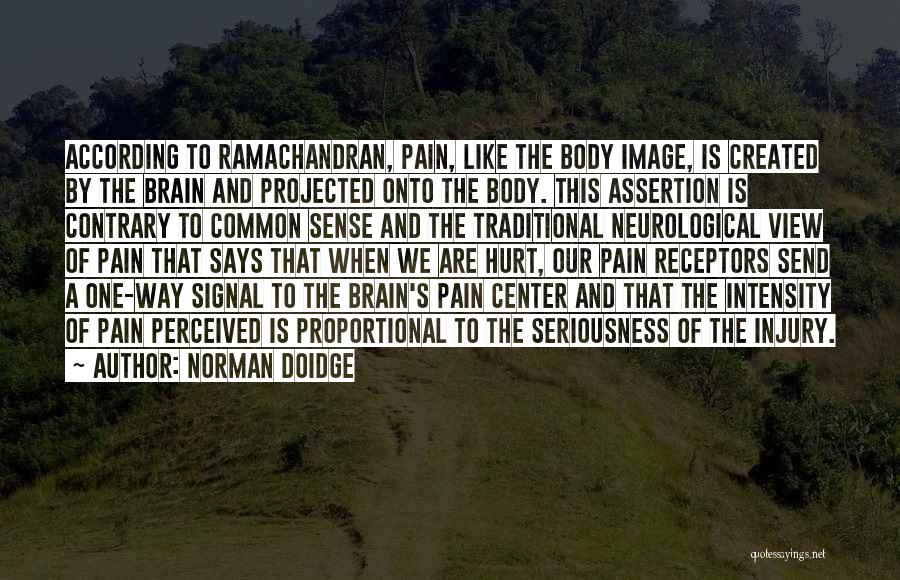
According to Ramachandran, pain, like the body image, is created by the brain and projected onto the body. This assertion is contrary to common sense and the traditional neurological view of pain that says that when we are hurt, our pain receptors send a one-way signal to the brain's pain center and that the intensity of pain perceived is proportional to the seriousness of the injury. — Norman Doidge
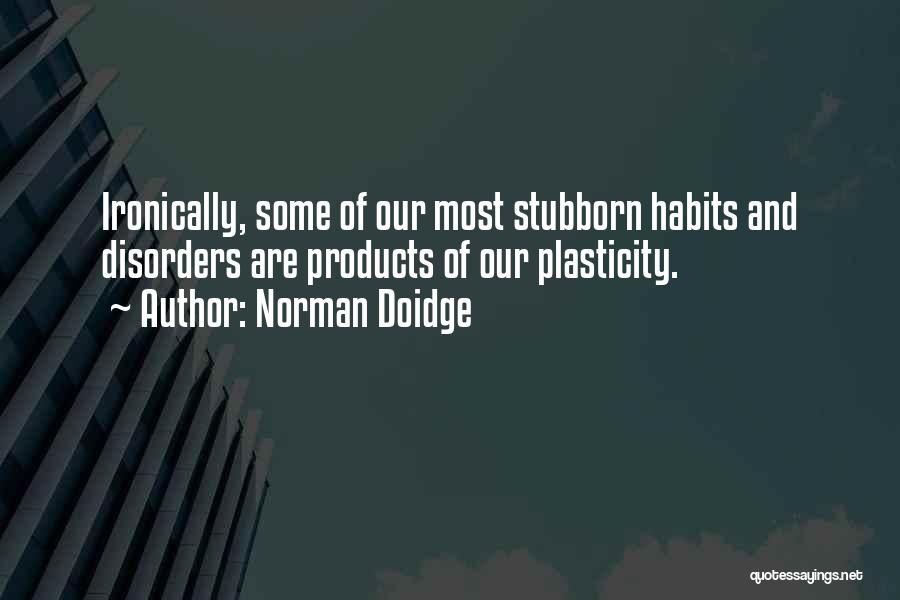
Ironically, some of our most stubborn habits and disorders are products of our plasticity. — Norman Doidge
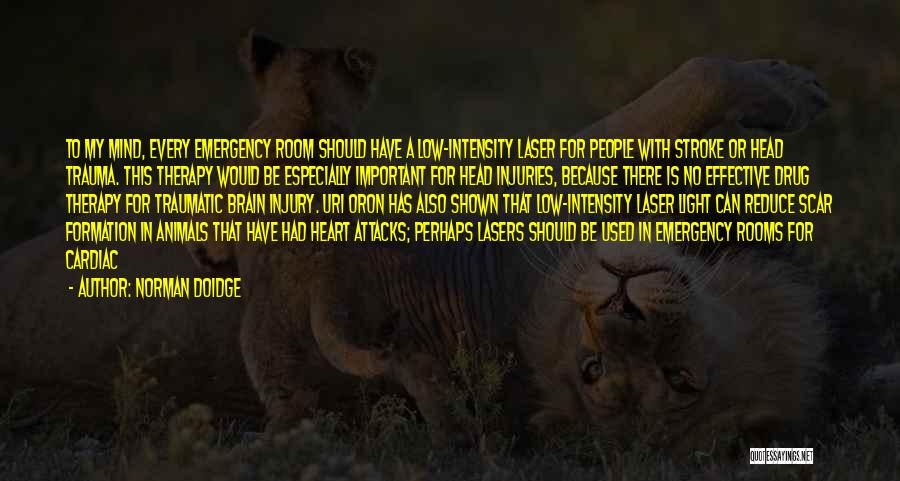
To my mind, every emergency room should have a low-intensity laser for people with stroke or head trauma. This therapy would be especially important for head injuries, because there is no effective drug therapy for traumatic brain injury. Uri Oron has also shown that low-intensity laser light can reduce scar formation in animals that have had heart attacks; perhaps lasers should be used in emergency rooms for cardiac — Norman Doidge
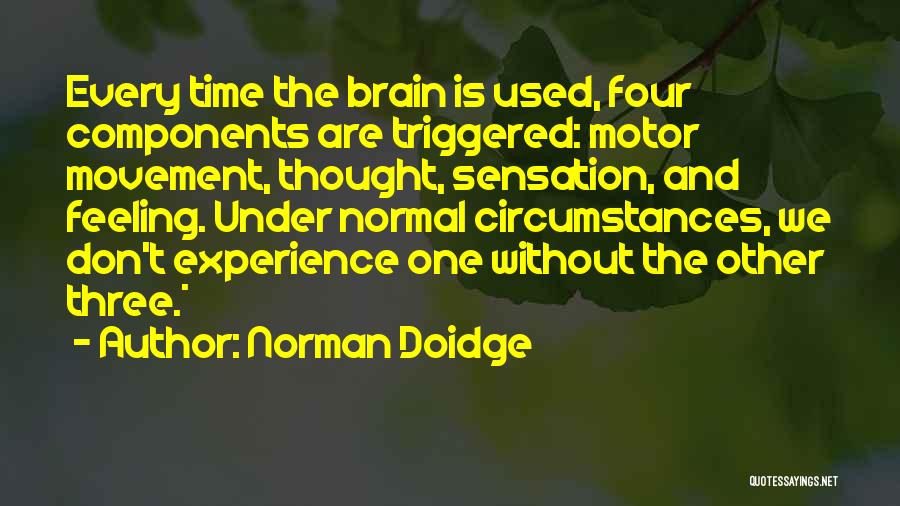
Every time the brain is used, four components are triggered: motor movement, thought, sensation, and feeling. Under normal circumstances, we don't experience one without the other three.* — Norman Doidge
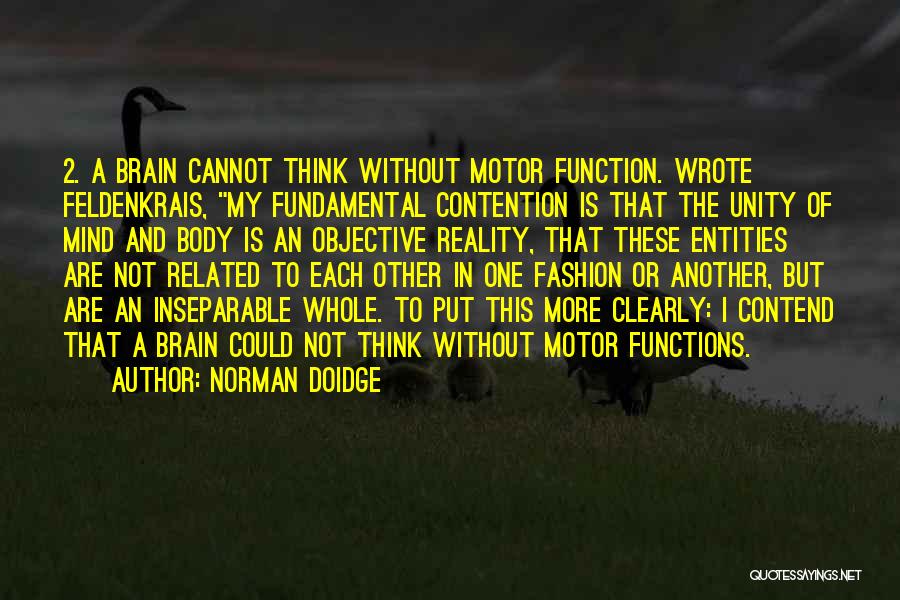
2. A brain cannot think without motor function. Wrote Feldenkrais, "My fundamental contention is that the unity of mind and body is an objective reality, that these entities are not related to each other in one fashion or another, but are an inseparable whole. To put this more clearly: I contend that a brain could not think without motor functions. — Norman Doidge
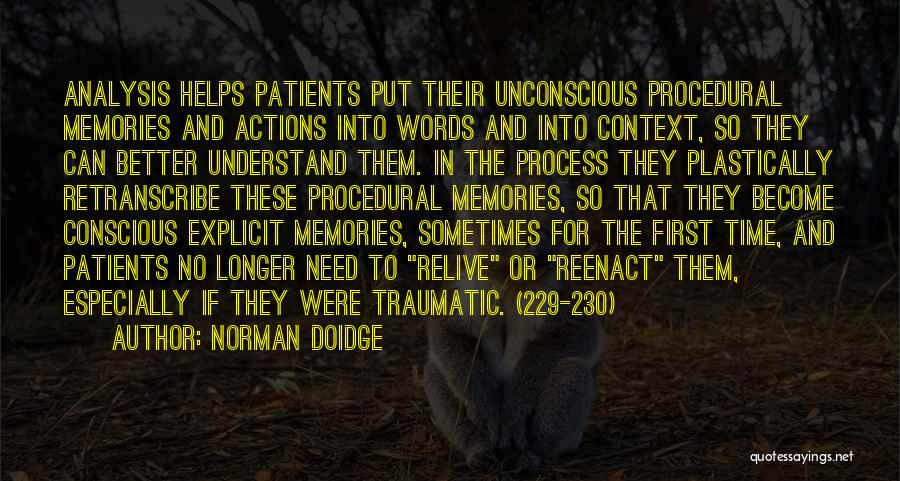
Analysis helps patients put their unconscious procedural memories and actions into words and into context, so they can better understand them. In the process they plastically retranscribe these procedural memories, so that they become conscious explicit memories, sometimes for the first time, and patients no longer need to "relive" or "reenact" them, especially if they were traumatic. (229-230) — Norman Doidge
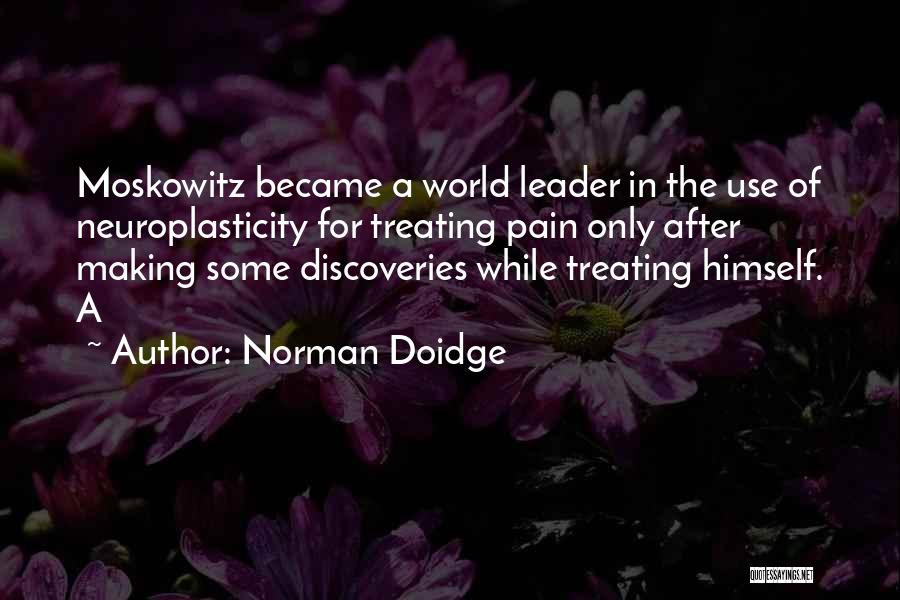
Moskowitz became a world leader in the use of neuroplasticity for treating pain only after making some discoveries while treating himself. A — Norman Doidge
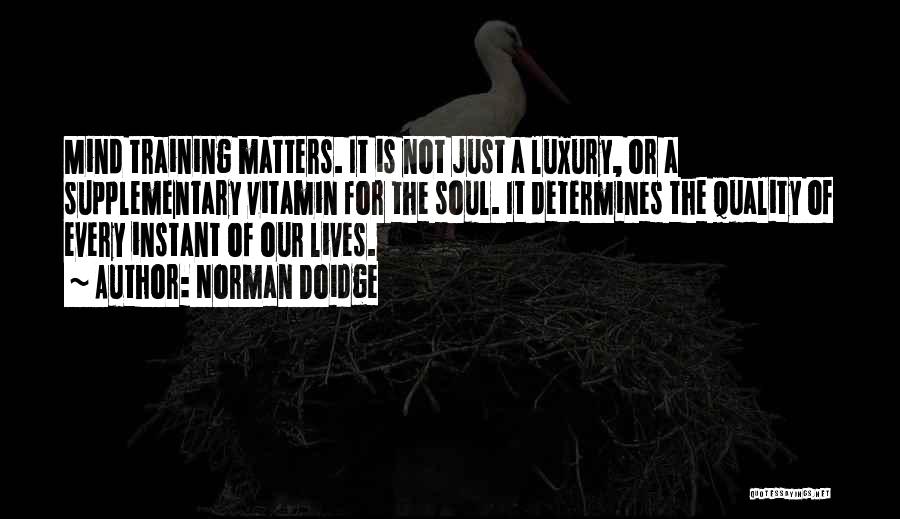
Mind training matters. It is not just a luxury, or a supplementary vitamin for the soul. It determines the quality of every instant of our lives. — Norman Doidge
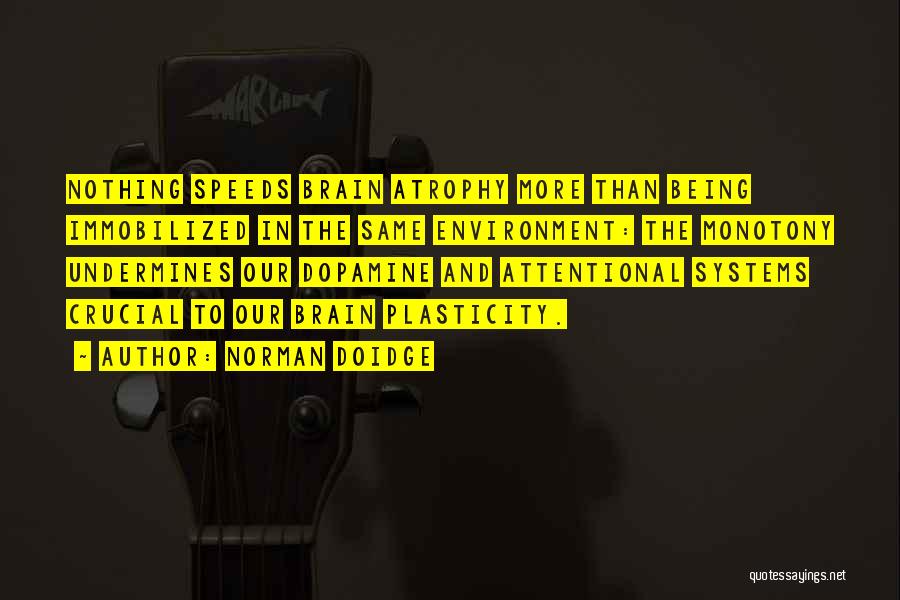
Nothing speeds brain atrophy more than being immobilized in the same environment: the monotony undermines our dopamine and attentional systems crucial to our brain plasticity. — Norman Doidge
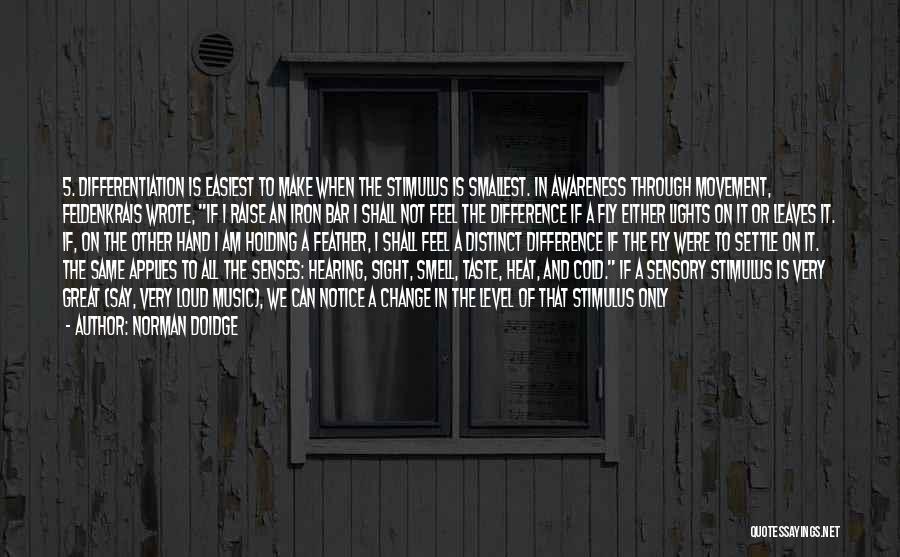
5. Differentiation is easiest to make when the stimulus is smallest. In Awareness Through Movement, Feldenkrais wrote, "If I raise an iron bar I shall not feel the difference if a fly either lights on it or leaves it. If, on the other hand I am holding a feather, I shall feel a distinct difference if the fly were to settle on it. The same applies to all the senses: hearing, sight, smell, taste, heat, and cold." If a sensory stimulus is very great (say, very loud music), we can notice a change in the level of that stimulus only if the change is quite significant. If the stimulus is small to begin with, then we can detect very small changes. (This phenomenon is called the Weber-Fechner law in physiology.) — Norman Doidge
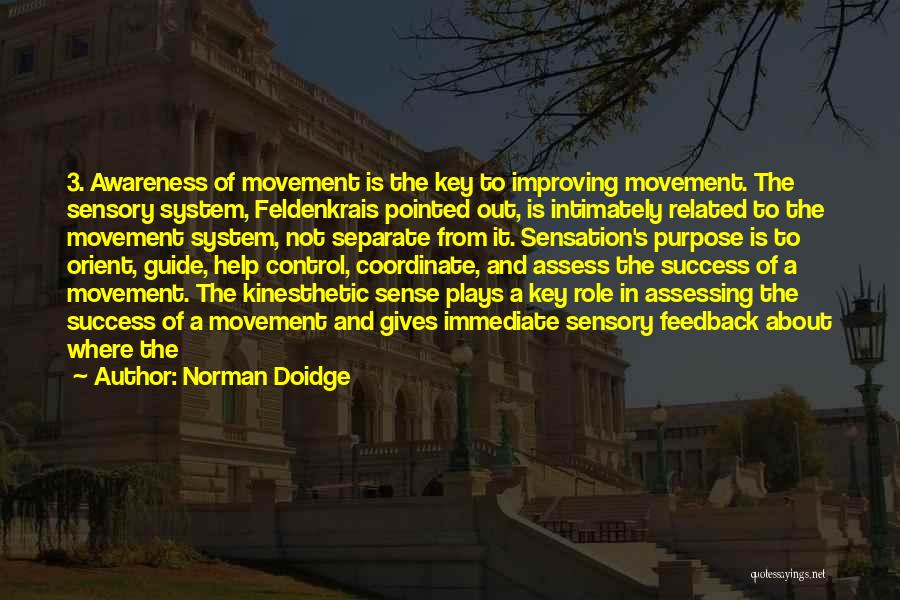
3. Awareness of movement is the key to improving movement. The sensory system, Feldenkrais pointed out, is intimately related to the movement system, not separate from it. Sensation's purpose is to orient, guide, help control, coordinate, and assess the success of a movement. The kinesthetic sense plays a key role in assessing the success of a movement and gives immediate sensory feedback about where the — Norman Doidge
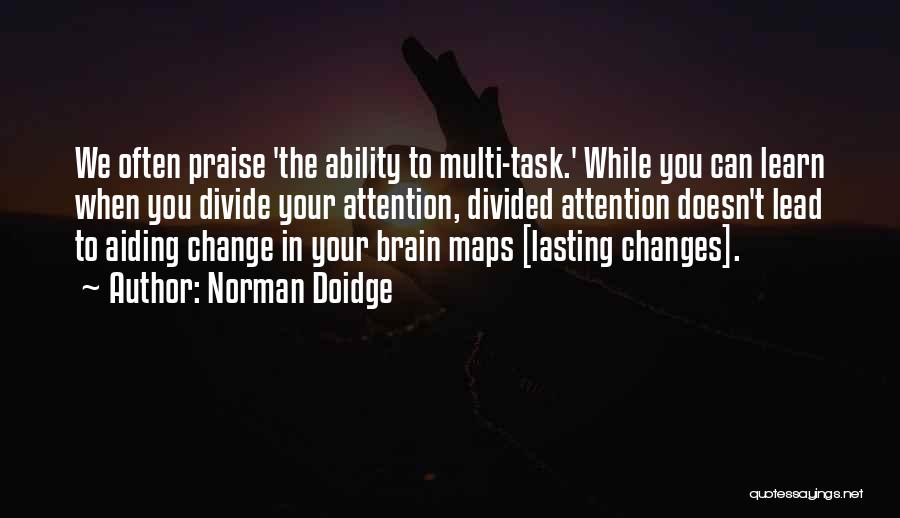
We often praise 'the ability to multi-task.' While you can learn when you divide your attention, divided attention doesn't lead to aiding change in your brain maps [lasting changes]. — Norman Doidge

In the course of my travels I met a scientist who enabled people who had been blind since birth to begin to see, another who enabled the deaf to hear; I spoke with people who had had strokes decades before and had been declared incurable, who were helped to recover with neuroplastic treatments; I met people whose learning disorders were cured and whose IQs were raised; I saw evidence that it is possible for eighty-year-olds to sharpen their memories to function the way they did when they were fifty-five. I saw people rewire their brains with their thoughts, to cure previously incurable obsessions and traumas. I spoke with Nobel laureates who were hotly debating how we must rethink our model of the brain now that we know it is ever changing. The — Norman Doidge
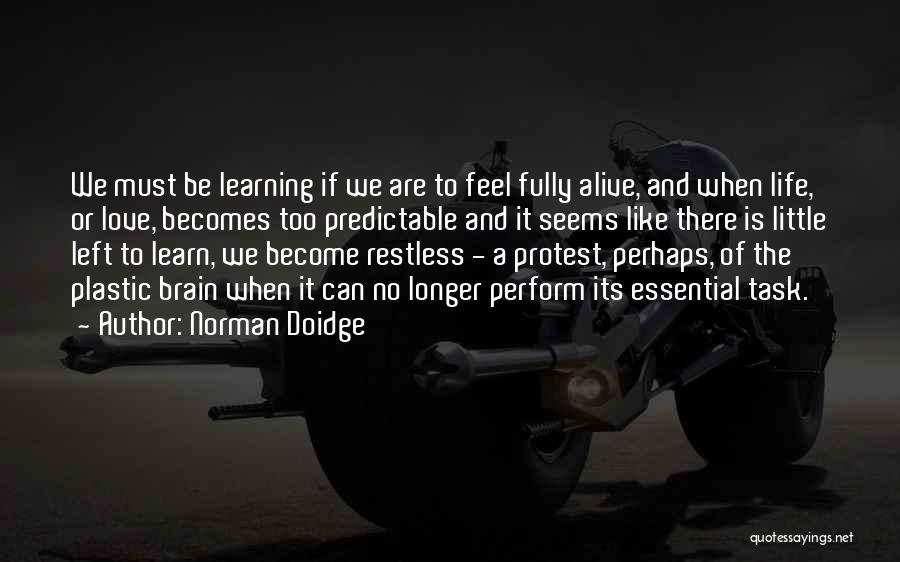
We must be learning if we are to feel fully alive, and when life, or love, becomes too predictable and it seems like there is little left to learn, we become restless - a protest, perhaps, of the plastic brain when it can no longer perform its essential task. — Norman Doidge
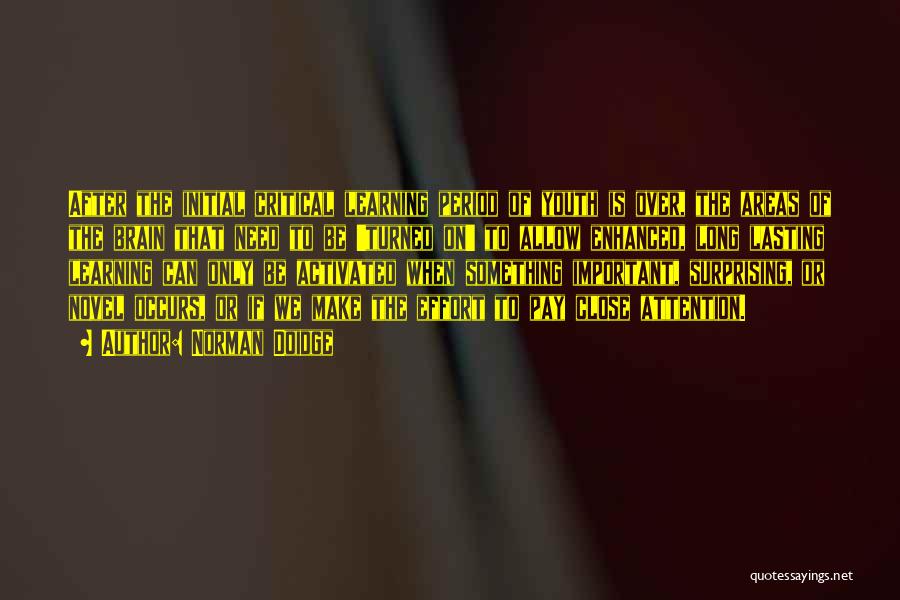
After the initial critical learning period of youth is over, the areas of the brain that need to be 'turned on' to allow enhanced, long lasting learning can only be activated when something important, surprising, or novel occurs, or if we make the effort to pay close attention. — Norman Doidge
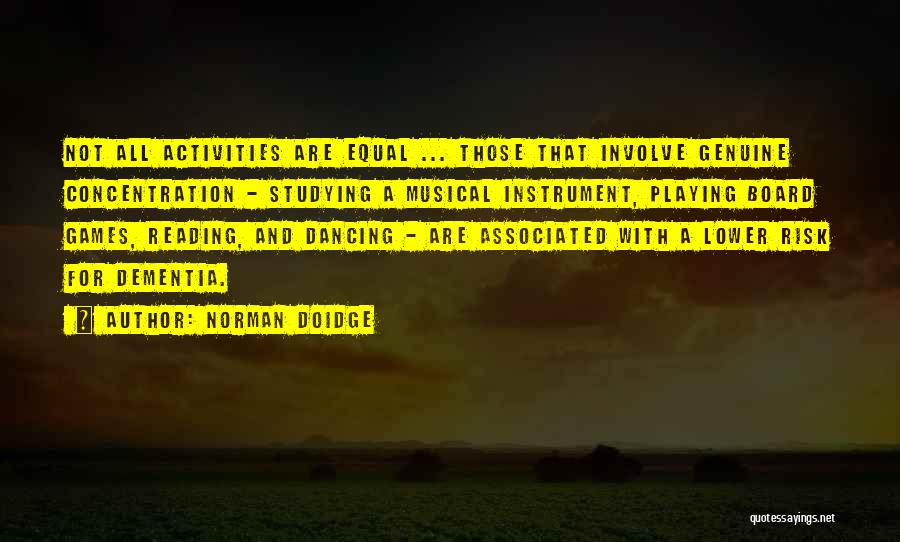
Not all activities are equal ... Those that involve genuine concentration - studying a musical instrument, playing board games, reading, and dancing - are associated with a lower risk for dementia. — Norman Doidge
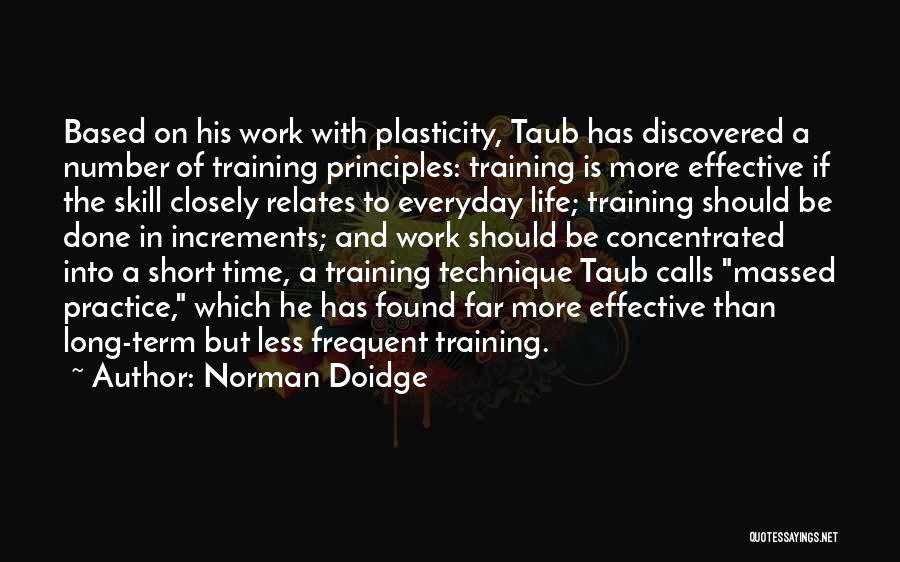
Based on his work with plasticity, Taub has discovered a number of training principles: training is more effective if the skill closely relates to everyday life; training should be done in increments; and work should be concentrated into a short time, a training technique Taub calls "massed practice," which he has found far more effective than long-term but less frequent training. — Norman Doidge
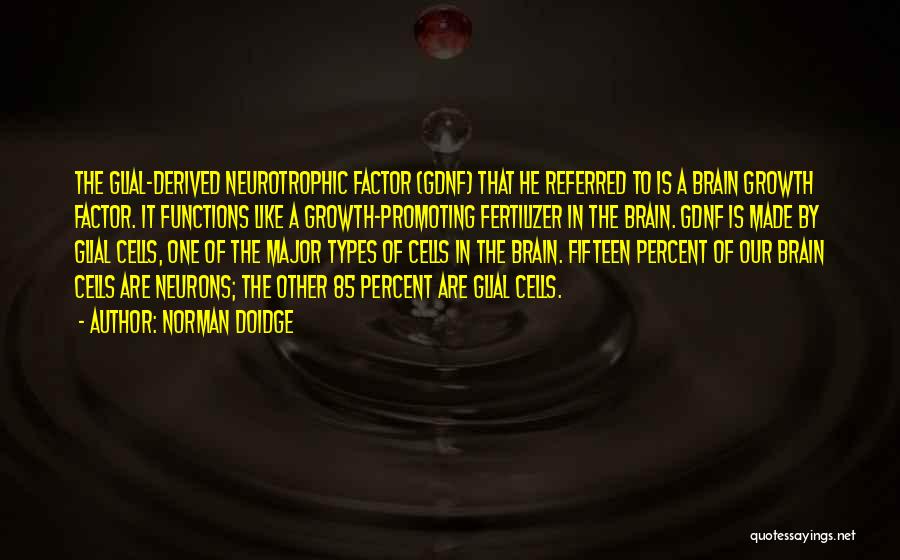
The glial-derived neurotrophic factor (GDNF) that he referred to is a brain growth factor. It functions like a growth-promoting fertilizer in the brain. GDNF is made by glial cells, one of the major types of cells in the brain. Fifteen percent of our brain cells are neurons; the other 85 percent are glial cells. — Norman Doidge
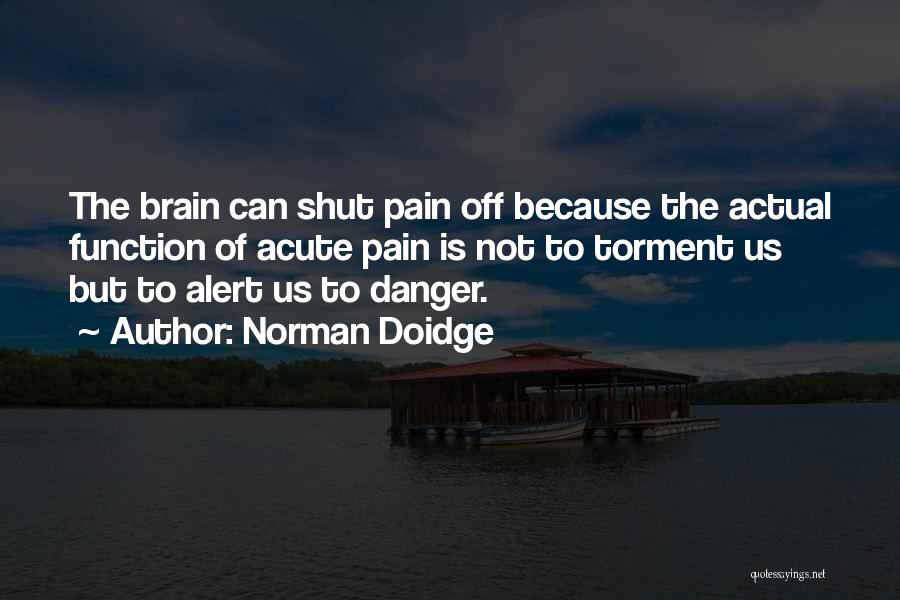
The brain can shut pain off because the actual function of acute pain is not to torment us but to alert us to danger. — Norman Doidge

All of us have worries. We worry because we are intelligent beings. Intelligence predicts, that is its essence; the same intelligence that allows us to plan, hope, imagine, and hypothesize also allows us to worry and anticipate negative outcomes. (164) — Norman Doidge
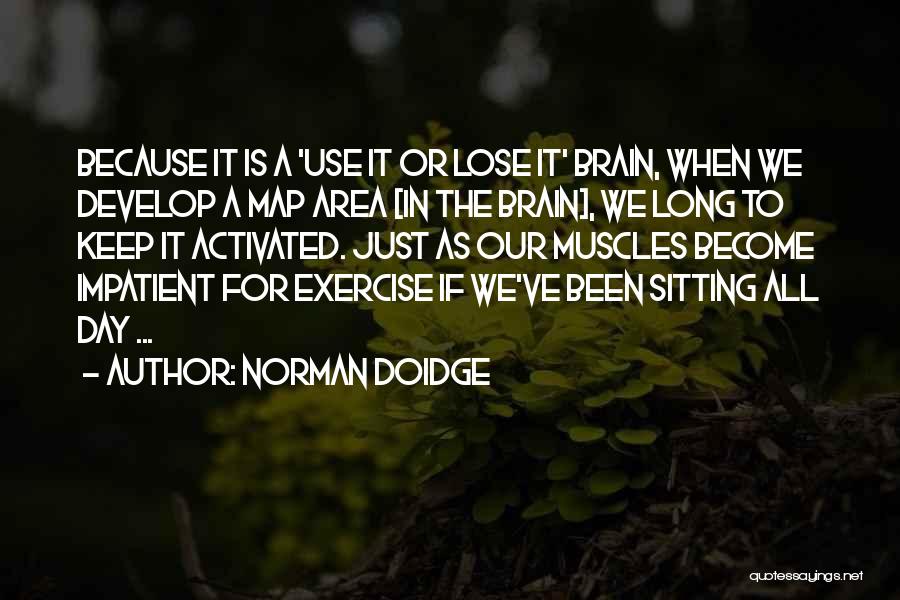
Because it is a 'use it or lose it' brain, when we develop a map area [in the brain], we long to keep it activated. Just as our muscles become impatient for exercise if we've been sitting all day ... — Norman Doidge
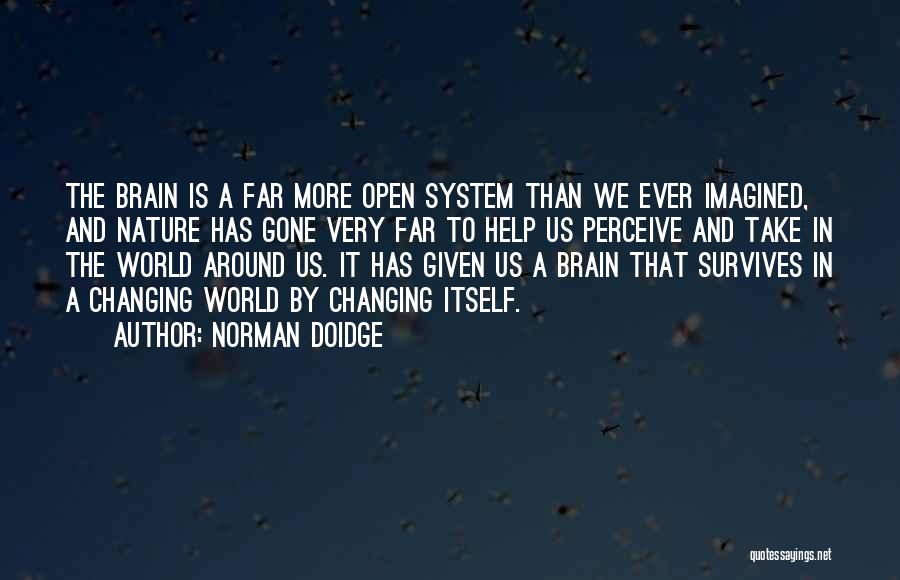
The brain is a far more open system than we ever imagined, and nature has gone very far to help us perceive and take in the world around us. It has given us a brain that survives in a changing world by changing itself. — Norman Doidge
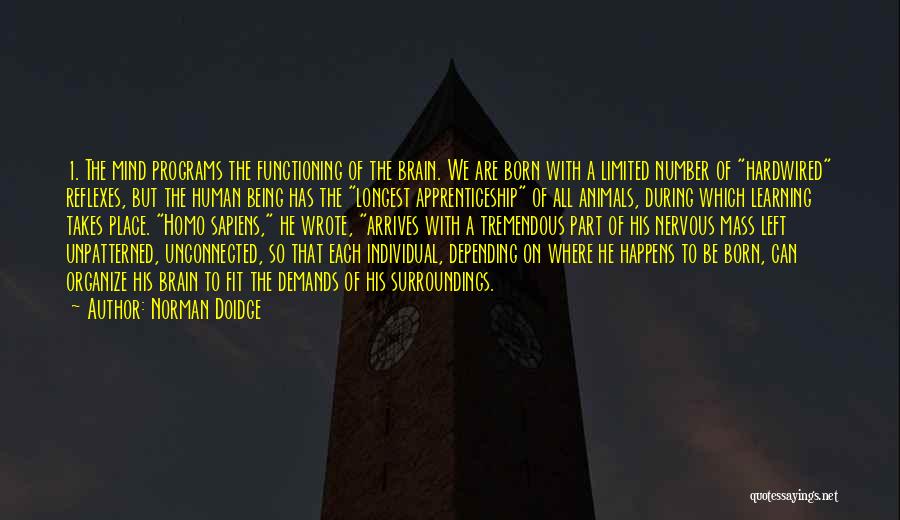
1. The mind programs the functioning of the brain. We are born with a limited number of "hardwired" reflexes, but the human being has the "longest apprenticeship" of all animals, during which learning takes place. "Homo sapiens," he wrote, "arrives with a tremendous part of his nervous mass left unpatterned, unconnected, so that each individual, depending on where he happens to be born, can organize his brain to fit the demands of his surroundings. — Norman Doidge
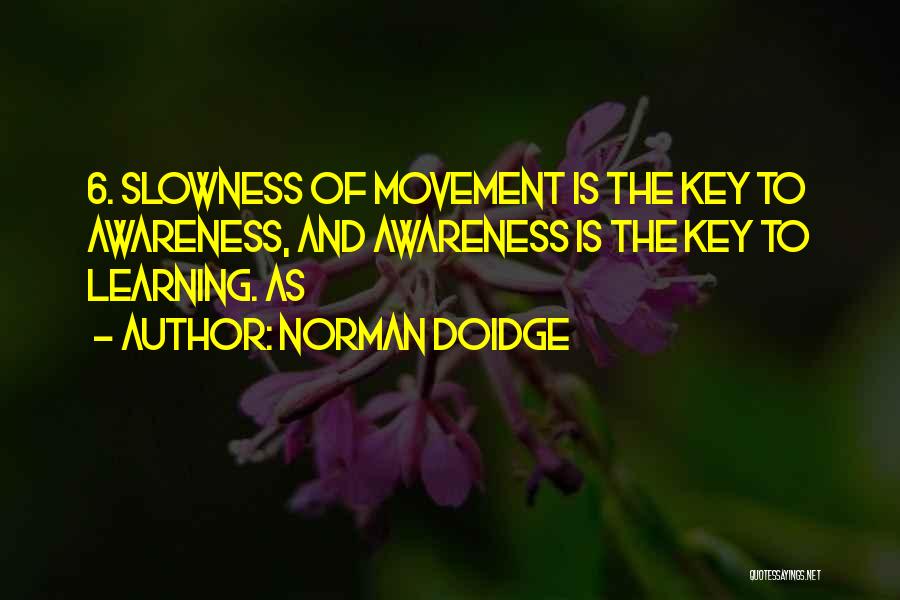
6. Slowness of movement is the key to awareness, and awareness is the key to learning. As — Norman Doidge
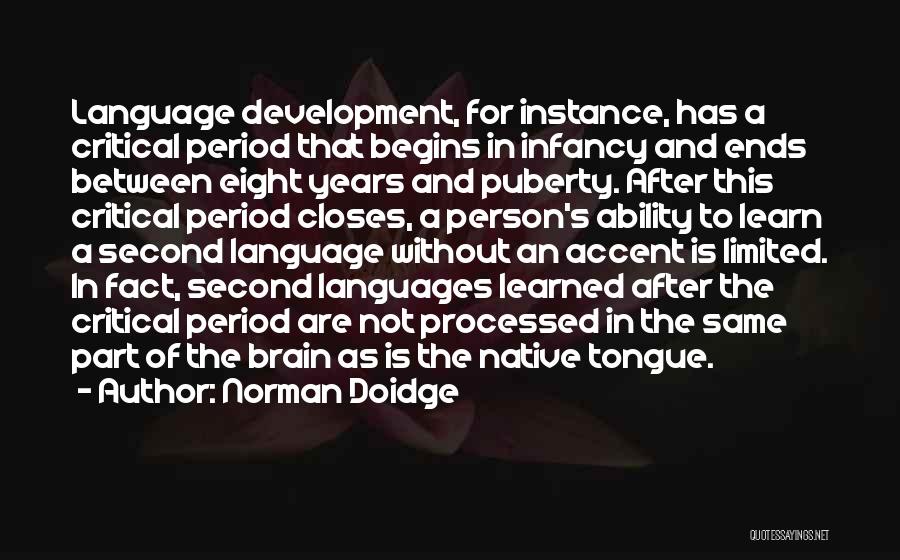
Language development, for instance, has a critical period that begins in infancy and ends between eight years and puberty. After this critical period closes, a person's ability to learn a second language without an accent is limited. In fact, second languages learned after the critical period are not processed in the same part of the brain as is the native tongue. — Norman Doidge
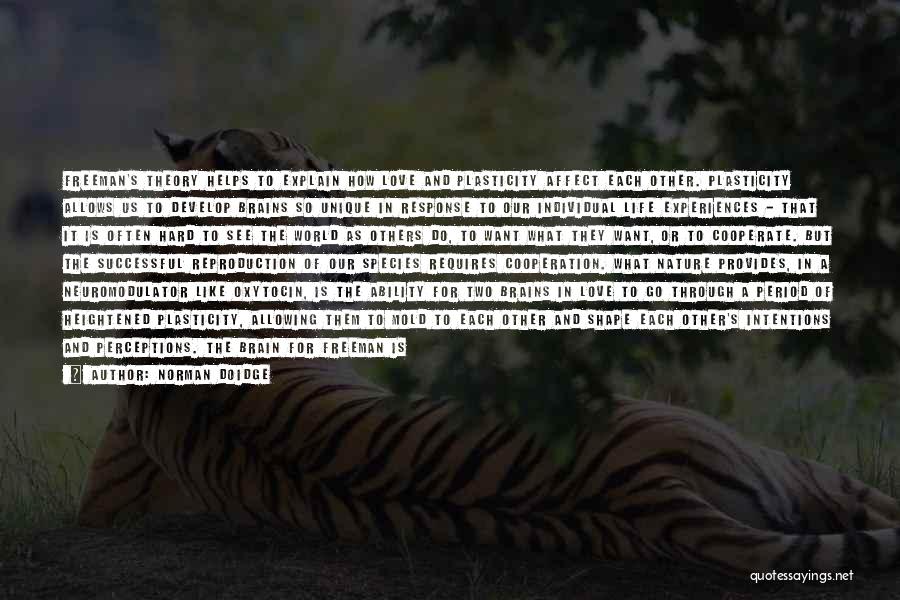
Freeman's theory helps to explain how love and plasticity affect each other. Plasticity allows us to develop brains so unique in response to our individual life experiences - that it is often hard to see the world as others do, to want what they want, or to cooperate. But the successful reproduction of our species requires cooperation. What nature provides, in a neuromodulator like oxytocin, is the ability for two brains in love to go through a period of heightened plasticity, allowing them to mold to each other and shape each other's intentions and perceptions. The brain for Freeman is fundamentally an organ of socialization, and so there must be a mechanism that, from time to time, undoes our tendency to become overly individualized, overly self-involved, and too self-centered. — Norman Doidge

Not all activities are equal in this regard. Those that involve genuine concentration - studying a musical instrument, playing board games, reading, and dancing - are associated with a lower risk for dementia. Dancing, which requires learning new moves, is both physically and mentally challenging and requires much concentration. Less intense activities, such as bowling, babysitting, and golfing, are not associated with a reduced incidence of Alzheimer's. (254) — Norman Doidge
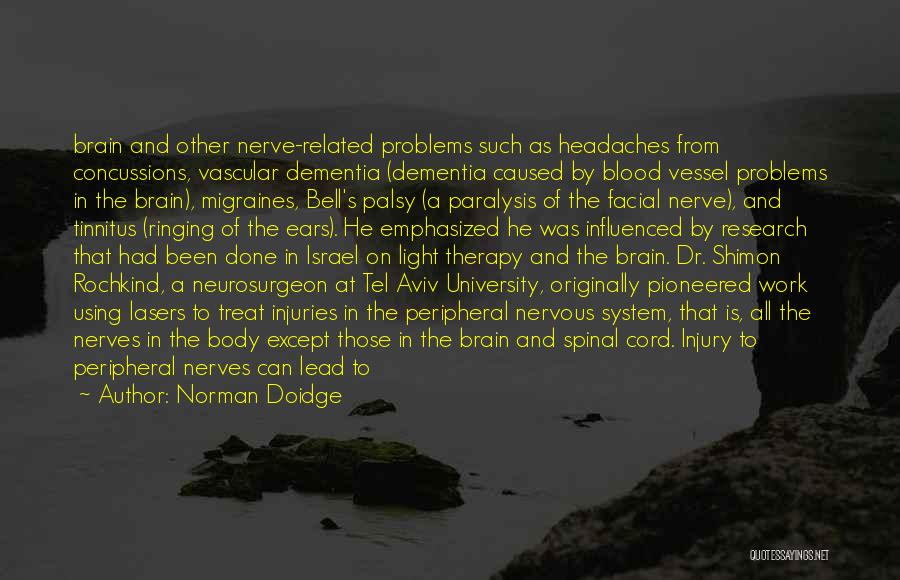
brain and other nerve-related problems such as headaches from concussions, vascular dementia (dementia caused by blood vessel problems in the brain), migraines, Bell's palsy (a paralysis of the facial nerve), and tinnitus (ringing of the ears). He emphasized he was influenced by research that had been done in Israel on light therapy and the brain. Dr. Shimon Rochkind, a neurosurgeon at Tel Aviv University, originally pioneered work using lasers to treat injuries in the peripheral nervous system, that is, all the nerves in the body except those in the brain and spinal cord. Injury to peripheral nerves can lead to problems sensing or moving. — Norman Doidge
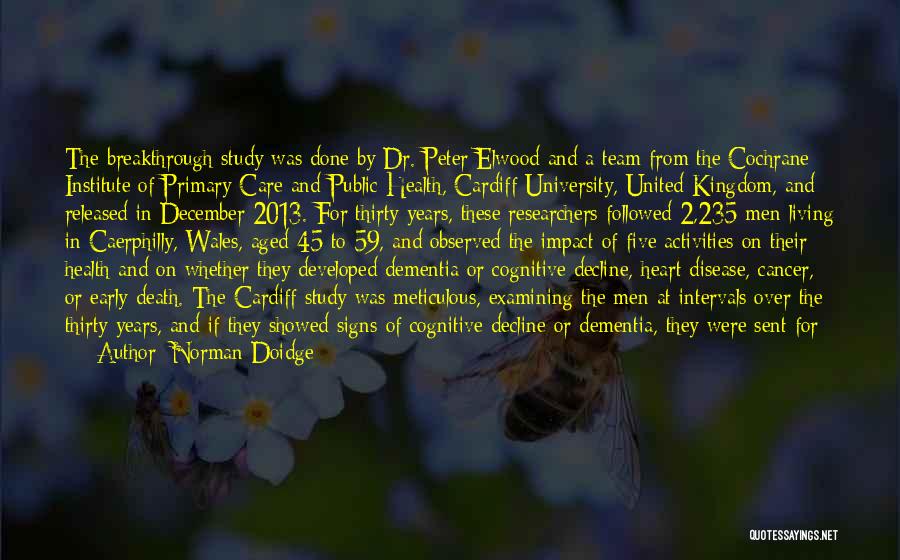
The breakthrough study was done by Dr. Peter Elwood and a team from the Cochrane Institute of Primary Care and Public Health, Cardiff University, United Kingdom, and released in December 2013. For thirty years, these researchers followed 2,235 men living in Caerphilly, Wales, aged 45 to 59, and observed the impact of five activities on their health and on whether they developed dementia or cognitive decline, heart disease, cancer, or early death. The Cardiff study was meticulous, examining the men at intervals over the thirty years, and if they showed signs of cognitive decline or dementia, they were sent for detailed clinical assessments of high quality. It overcame study design problems from eleven previous studies (discussed in the endnotes). Results showed that if the men did four or five of the following behaviors, their risk for cognitive (mental) decline and dementia (including Alzheimer's) fell by 60 percent: — Norman Doidge
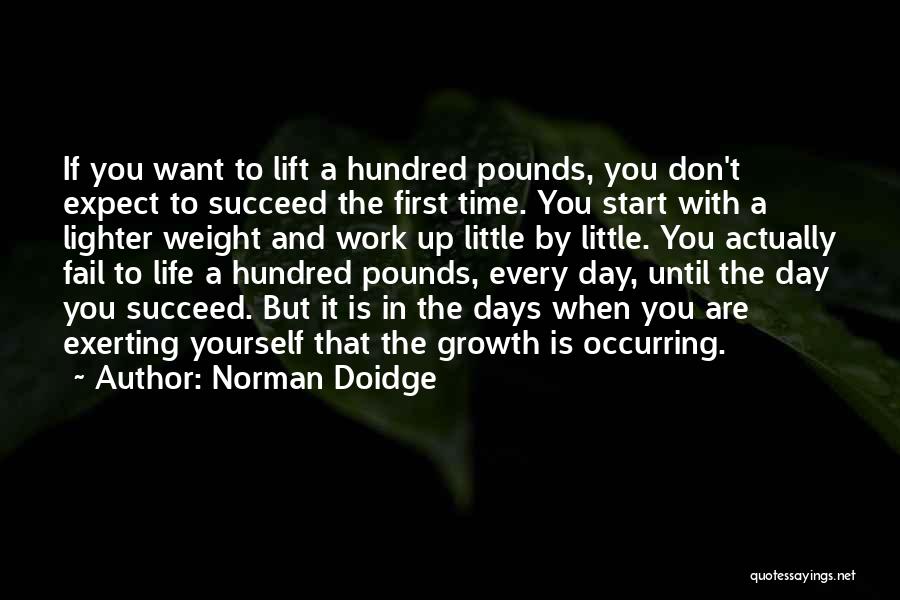
If you want to lift a hundred pounds, you don't expect to succeed the first time. You start with a lighter weight and work up little by little. You actually fail to life a hundred pounds, every day, until the day you succeed. But it is in the days when you are exerting yourself that the growth is occurring. — Norman Doidge
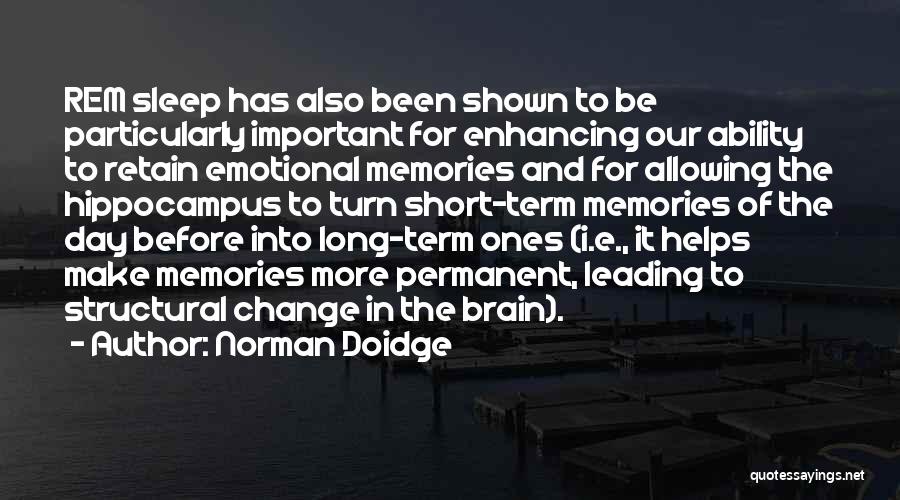
REM sleep has also been shown to be particularly important for enhancing our ability to retain emotional memories and for allowing the hippocampus to turn short-term memories of the day before into long-term ones (i.e., it helps make memories more permanent, leading to structural change in the brain). — Norman Doidge
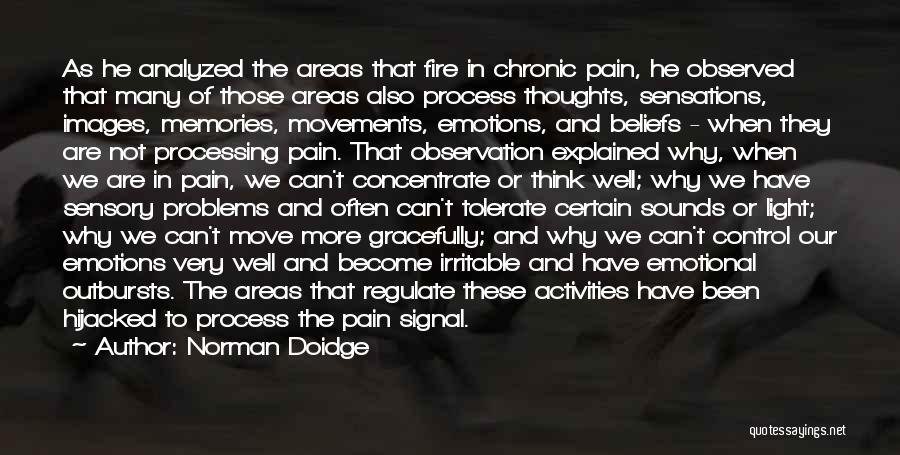
As he analyzed the areas that fire in chronic pain, he observed that many of those areas also process thoughts, sensations, images, memories, movements, emotions, and beliefs - when they are not processing pain. That observation explained why, when we are in pain, we can't concentrate or think well; why we have sensory problems and often can't tolerate certain sounds or light; why we can't move more gracefully; and why we can't control our emotions very well and become irritable and have emotional outbursts. The areas that regulate these activities have been hijacked to process the pain signal. — Norman Doidge

We have senses we don't know we have-until we lose them; balance is one that normally works so well, so seamlessly, that is not listed among the five that Aristotle described and was overlooked for centuries afterward. — Norman Doidge
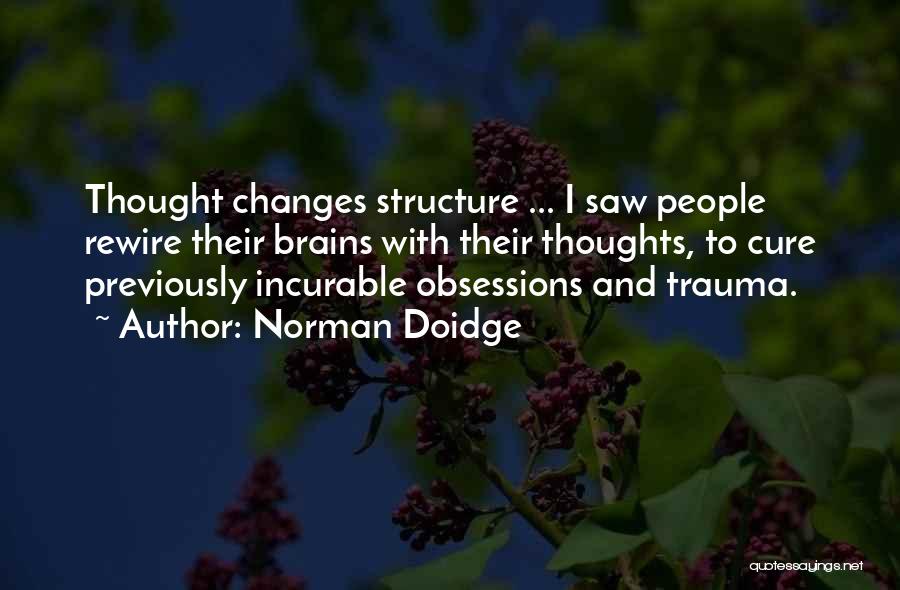
Thought changes structure ... I saw people rewire their brains with their thoughts, to cure previously incurable obsessions and trauma. — Norman Doidge






